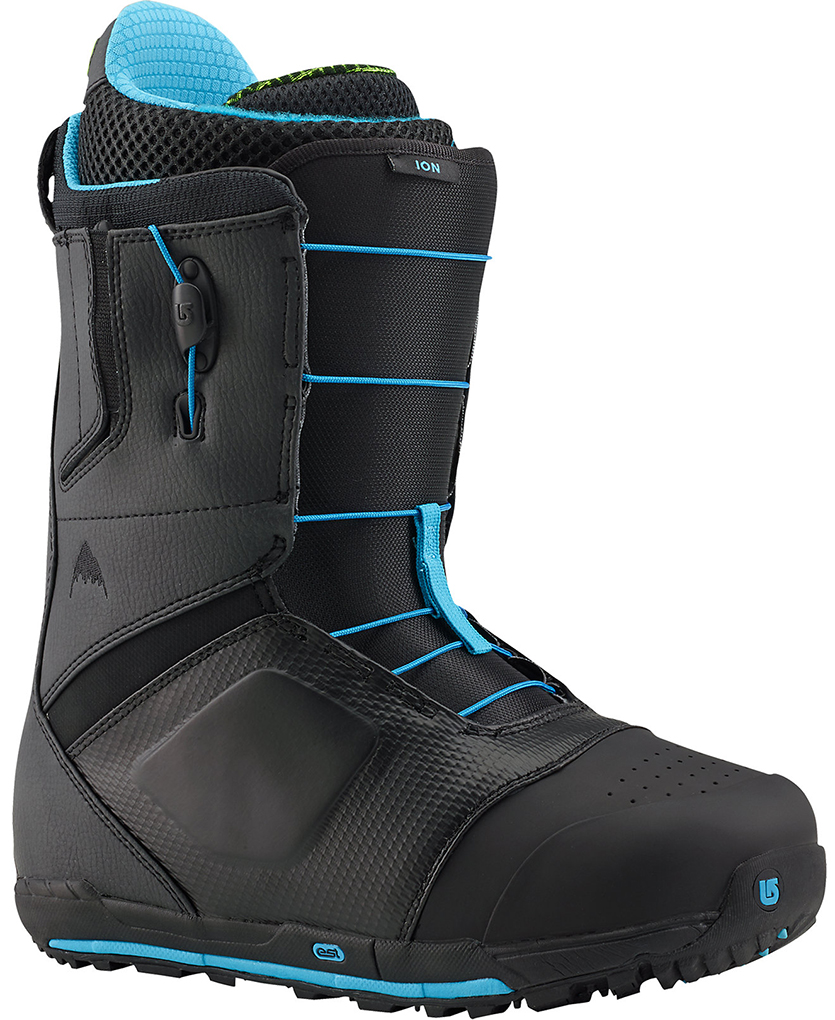
2015-2016 Burton Ion
MSRP: $450
Features:
- Shrinkage Footprint Reduction Technology
- Speed Zone Lacing System
- Dual-density Firm Flex PowerUP Tongue
- Infinite Ride 4 Liner
- GripLITE Backstay
- Low-Profile EST Optimized Midsole
- AutoCANT Cushioning
- ReBounce Cushioning
- Sleeping Bag Reflective Foil
- Outer Shell Pressure Relief Panel
- ESS Support Shank
Used with: Burton Diode EST binding (Medium)
Test Locations: Maine, Vermont, France, Switzerland, Austria.
Days Tested: 40+
[Editor’s Note: We reviewed the 2014-2015 model of the Ion, and the boot returns mostly unchanged for the 2015-2016 season. Burton has made a slight tweak to the Speed Zone lacing system on the 2016 model, introducing new lace guide and cleats, but it is otherwise the same as the 2014-2015 version reviewed here.]
The top-of-the-line SLX is the most expensive boot Burton makes, but it’s a relatively new addition to the line, while the Ion (which has been around for years), is arguably the most popular boot Burton has ever made.
We’ll get to a review of the newer SLX soon, but before we do, we wanted to first take a look at the boot that’s been a staple in the Burton line.
Evolution of the Ion
I’ve ridden the Ion on and off for the past few years, but the boot’s materials changed about three years ago and I found that it deteriorated much faster than usual. Because of this, I stopped riding in the Ion for a while, but Burton tweaked the design again this season, turning it into a stiffer, more technical boot that has a longer life than most.
The Ion saw two significant changes for 2015: (1) Burton’s switch from flexible foam material in the toe box to a firm plastic cap, and (2) new rigid metal stays up through the Achilles area to add support and resiliency to the boot’s flex.

Fit
I’ve found the fit of the Ion to be pretty good once some adjustments are made. Out of the box, the boot has a snug fit with little room for extra movement; both the toe and heel feel well-supported and padded, with just enough wiggle room. I did add L-pads around the Achilles tendon area of the Ion’s liner to keep my heel locked down better. I also use a custom footbed in my boots, which provides a little more padding and support under my arch, as well as a heel cushion. I still get a bit of heel lift in the Ion in a size 10.5, but have been willing to live with it given the boot’s performance.
With enough riding time, any liner will pack out some, you may develop some heel lift, and the boot’s flex with soften some. The Ion seems to be especially resilient in this respect, though, because after more than 40 days of riding, when I crank my boots as tight as I can for competition, they still provide enough stiffness and good response and are highly reliable. In my experience, previous versions of the Ion didn’t offer the same long-lasting performance.
It’s also worth mentioning that Burton’s Shrinkage Footprint Reduction Technology, in their words, “reduces the boot’s overall footprint one full size, meaning a men’s size 10 fits like a size 10, but has the footprint of a typical size 9.” This goes a long way in minimizing toe drag and is a great feature of the Ion, and all Burton’s boots.
The Ion fit like a glove in my bindings (Burton Diode EST). I found the fit to be almost too snug, in fact, as I really had to jam my heel in to ensure the boots were fully seated in each binding’s heel hoop.
Flex & Performance
On my first day out in the Ion, the boot felt surprisingly stiff. I mean ultra stiff – ski boot stiff.
But within three days, the Ion broke in enough to feel like a favorite pair of shoes, yet remained responsive throughout this 40 day test. Burton rates these boots as an 8 out of 10 in terms of their flex. Out of the box, I’d agree, though after 40 days, I’d say the boots’ flex is holding at solid 6.5 for me. The Ion is not the stiffest boot imaginable, but it’s definitely stiff and resilient enough to ride out a 100+ day season.
I am also unable to flex / bend the Ion’s sole between my hands, and that stiffness is a benefit for climbing technical snowboard mountaineering routes in crampons.

As a rider on the Freeride World Tour, I like a stiff boot, but I also want something comfortable to ride in all season, and the Ion delivers in this respect. It’s comfortable, warm, supportive, and dry, which are all qualities that add up to a foundation for good, solid performance. The Ion breaks in well over time, and even now, after a full season of riding, I’d trust them in AK..
Any intermediate to expert rider who is riding at least 20 days a year is likely to appreciate this boot. It takes a bit of time to break in, especially if you are not hiking, touring, or spending over 10 hours in the boots per day, but offers solid, dependable performance long after that initial break in period.

Hi Colin,
I have a pair of these 14/15 ions and have ridden only about ten days in them so far. You mention that they become more comfortable with time, but have you found the length to pack out at all? I bought them half a size too small, hoping they’ll lengthen just a little, not much yet though.
Cheers
Andrew